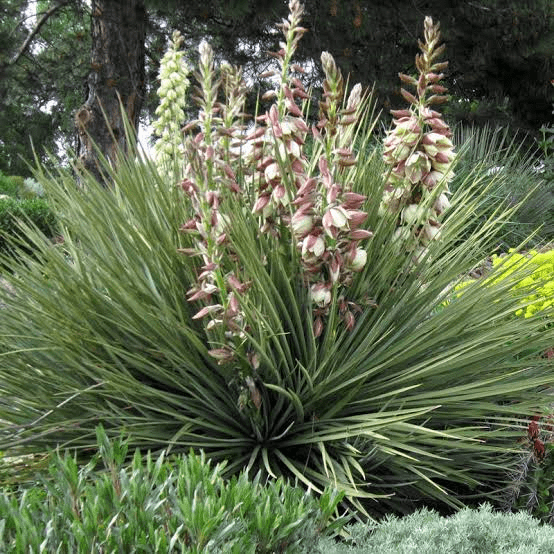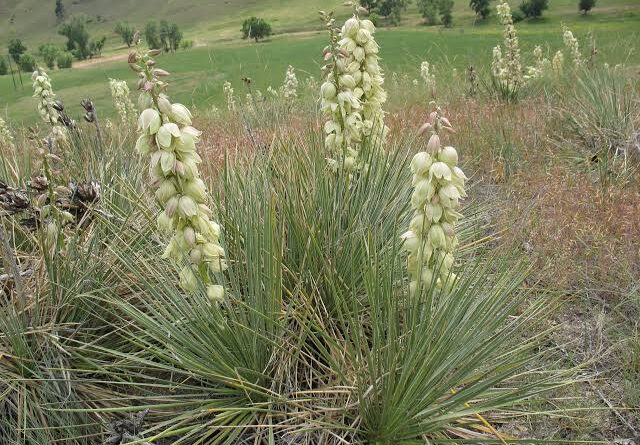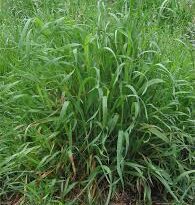5 Medicinal Health Benefits Of Yucca glauca (Soapweed Yucca)
Yucca glauca, commonly known as Soapweed Yucca, is a distinctive and versatile plant that belongs to the Asparagaceae family. This perennial succulent is native to the central and western regions of North America, where it thrives in a variety of habitats, from arid deserts to grasslands.
The name Soapweed is derived from its traditional use among indigenous peoples, who utilized the plant’s fibrous leaves to make soap and various other practical applications. In this article, we will explore the remarkable features and characteristics of Yucca glauca, delving into its appearance, habitat, cultural significance, and ecological roles.
Yucca glauca is a visually striking plant that stands out in the landscapes it inhabits. Its rosette-shaped cluster of narrow, sword-like leaves can reach heights of 2 to 3 feet (0.6 to 0.9 meters). These leaves are typically bluish-gray or greenish-blue in color, hence the species name “glauca,” which means “bluish-gray” in Latin.
The leaves are rigid and have sharp, pointed tips, making them well-adapted to the arid environments in which they grow. The plant’s unique aesthetic makes it a popular choice in xeriscaping and arid landscaping, adding a touch of southwestern flair to gardens.
The flowers of Yucca glauca are a prominent feature. In late spring to early summer, it produces tall, impressive flower stalks that can reach up to 6 feet (1.8 meters) in height. The flower clusters are dense, composed of creamy-white, bell-shaped flowers that dangle from the stalk.
These fragrant blooms attract pollinators, particularly yucca moths, which have a mutualistic relationship with the plant. Yucca moths are the primary pollinators of Soapweed Yucca, and they lay their eggs in the plant’s flowers, ensuring its reproductive success.
Soapweed Yucca is highly adaptable and can be found in a wide range of habitats, from dry deserts to grasslands and prairies. It is distributed throughout central and western North America, including parts of the United States such as Colorado, Wyoming, Montana, and Nebraska. Its ability to thrive in arid regions is a testament to its resilience and ability to conserve water, a characteristic typical of yucca species.
In the wild, Yucca glauca often grows in sandy or rocky soils, and it is well-suited to areas with full sun exposure. Its deep root system enables it to access water sources even in drought-prone environments, and this resilience is crucial to its survival in such habitats.
Yucca glauca has a rich cultural history and has been utilized by various indigenous peoples for centuries. One of its most well-known uses is in soap production.
The fibrous leaves of the plant contain natural saponins, which are soap-like substances. Indigenous tribes would crush and soak the leaves to extract the saponins, creating a soapy lather that was used for cleaning clothing and cooking utensils. This practical application of Yucca glauca earned it the common name Soapweed.
Additionally, various parts of the plant have been used for medicinal purposes. Indigenous groups have employed the root of the plant to treat various ailments, including skin conditions and digestive issues. The leaves, too, have been used in traditional medicine for their anti-inflammatory and antiseptic properties.
In some Native American cultures, Yucca glauca holds symbolic significance. It is associated with resilience, adaptability, and endurance, qualities that are highly valued in arid regions where the plant thrives. Its presence in tribal legends and ceremonies further illustrates its cultural importance.
Yucca glauca plays several vital roles in its native ecosystems. As a pollinator-dependent plant, it supports the yucca moth (Tegeticula spp.), which relies on the Soapweed Yucca as its exclusive host plant. Yucca moths are responsible for pollinating the yucca’s flowers, and in return, they lay their eggs in the developing fruit.
This relationship benefits both the plant and the moth, ensuring the yucca’s reproduction while providing a food source for the moth’s larvae.
Furthermore, the plant’s fibrous leaves and tough, spiky structure provide shelter and protection for various small animals and insects. Its ability to thrive in arid environments also helps prevent soil erosion, as its extensive root system stabilizes the soil, reducing the risk of desertification.
In gardening and landscaping, Soapweed Yucca is a popular choice for xeriscaping projects, as its drought tolerance and striking appearance make it a valuable addition to water-wise landscapes. Its ability to thrive with minimal water requirements makes it an eco-friendly choice for those seeking to conserve water in their gardens.
In conclusion, Yucca glauca, or Soapweed Yucca, is a remarkable plant with a rich history of practical uses and cultural significance. Its adaptability to arid environments, striking appearance, and ecological roles make it a plant of great importance in its native regions.
Whether in the wild or in cultivated landscapes, this yucca species stands as a testament to nature’s resilience and the harmonious relationships that exist within ecosystems. From soap-making to its role in pollination, Yucca glauca is a plant that embodies the interconnectedness of life in arid landscapes.
The Botanical Description of Yucca glauca
Yucca glauca, commonly known as soapweed yucca, is a perennial evergreen plant belonging to the Asparagaceae family. This hardy succulent species is native to North America, specifically found in arid regions of the United States and Canada. Here is a detailed botanical description of Yucca glauca:
1. Appearance: Yucca glauca features a rosette of long, sword-shaped leaves. These leaves are stiff, narrow, and can reach up to 60 centimeters in length. The leaves are usually bluish-green in color, giving the plant its “glauca” epithet, which means “blue-gray” in Latin.
2. Flowers: During the plant’s flowering season, which typically occurs in late spring to early summer, Yucca glauca produces tall flower spikes. The spikes can reach impressive heights, often exceeding one meter. The flowers are pendulous, bell-shaped, and creamy-white in color. Yucca glauca is known for its striking and fragrant blossoms, attracting pollinators such as yucca moths.
3. Root System: Yucca glauca has a robust and extensive root system, enabling it to withstand harsh environmental conditions, including drought. The deep taproot anchors the plant firmly into the soil, allowing it to access water sources deep underground.
4. Habitat: Soapweed yucca is well-adapted to thrive in arid and semi-arid ecosystems. It is commonly found in prairies, desert grasslands, and sandy soils. Yucca glauca has evolved unique adaptations, such as its succulent leaves and water-efficient root system, to survive in regions with limited water availability.
The Geographic Distribution of Yucca glauca
Yucca glauca is primarily distributed across the western and central regions of North America. Here are some key points regarding its geographic distribution:
1. United States: Soapweed yucca is widespread in the United States, particularly in states such as Colorado, Arizona, New Mexico, Kansas, Nebraska, Wyoming, and South Dakota. It is a characteristic plant of the Great Plains region.
2. Canada: In Canada, Yucca glauca is found in the southern regions of Alberta and Saskatchewan. Its presence in these provinces signifies its ability to adapt to varying climatic conditions, including colder temperatures.
3. Habitat Preference: Yucca glauca prefers open, sunny habitats with well-draining soils. It thrives in grasslands, prairies, and desert areas. Its ability to grow in diverse habitats contributes to its wide geographic distribution.
4. Ecological Significance: Within its native range, Yucca glauca plays a vital ecological role. It provides food and habitat for various wildlife species, including birds and insects. Additionally, its deep roots help prevent soil erosion in arid environments.
The Chemical Composition of Yucca glauca
Yucca glauca possesses a rich chemical composition, including various phytochemicals that contribute to its medicinal and ecological significance. Here are some key components found in Yucca glauca:
1. Saponins: Yucca glauca contains saponins, natural compounds with soap-like properties. These saponins have been traditionally used by indigenous communities for their cleansing and foaming abilities. In the natural environment, saponins play a role in plant defense against herbivores.
2. Polyphenols: Polyphenolic compounds, including flavonoids and phenolic acids, are present in Yucca glauca. These polyphenols have antioxidant properties, protecting the plant from oxidative stress and potentially offering health benefits to consumers.
3. Alkaloids: While present in small quantities, alkaloids have been detected in Yucca glauca. Alkaloids often serve as natural pesticides, deterring herbivores from consuming the plant. Their presence highlights the plant’s defense mechanisms.
4. Medicinal Uses: Yucca glauca has a history of medicinal use among Native American tribes. Its extracts have been used to treat various ailments, including arthritis and joint pain. The plant’s chemical compounds, including saponins, are believed to contribute to its potential therapeutic effects.
Yucca glauca, with its distinctive botanical features and diverse chemical composition, stands as a resilient and valuable species in North American ecosystems. Its adaptability, ecological significance, and historical uses underscore its importance in both natural environments and traditional practices.
Read Also: Organic Foods and Organic Standards Guide
The Medicinal Health Benefits Of Yucca glauca (Soapweed Yucca)

Yucca glauca, commonly known as soapweed yucca, has a rich history of traditional medicinal uses among Native American tribes. It offers a range of potential health benefits, many of which are attributed to its unique chemical composition. Here are the key medicinal health benefits of Yucca glauca:
1. Anti-Inflammatory Properties: Yucca glauca contains compounds such as saponins and polyphenols that have demonstrated anti-inflammatory effects. These properties make it a potential natural remedy for conditions involving inflammation, such as arthritis and joint pain.
2. Joint Health: Yucca glauca has been used to support joint health and reduce the symptoms of conditions like osteoarthritis. It is believed to help alleviate pain and improve mobility in individuals with joint issues.
3. Antioxidant Action: The polyphenolic compounds found in Yucca glauca have antioxidant properties. These antioxidants can help protect cells from oxidative stress and may contribute to overall health and well-being.
4. Immune System Support: Some traditional uses of Yucca glauca involve its potential to support the immune system. It is thought to enhance the body’s natural defense mechanisms against illnesses.
5. Skin Health: The soap-like saponins in Yucca glauca have been used for their cleansing and soothing properties. They are sometimes incorporated into skincare products to address skin conditions like eczema and psoriasis.
The Methods of Usage to Achieve the Provided Health Benefits Of Yucca glauca (Soapweed Yucca)
To harness the medicinal health benefits of Yucca glauca, various methods of usage have been employed over the years. Here are the common methods of usage:
1. Herbal Preparations: Yucca glauca can be prepared in various herbal forms, including teas, tinctures, and capsules. These preparations are consumed to obtain the plant’s health benefits. For joint health and anti-inflammatory effects, a yucca tea or tincture may be taken.
2. Topical Applications: Yucca glauca extracts, such as yucca root powder, can be used topically on the skin to address skin conditions. They are often added to creams, lotions, or salves for soothing and cleansing purposes.
3. Dietary Inclusion: In some cultures, Yucca glauca is incorporated into the diet. The leaves can be prepared and consumed, often after baking or cooking, as a source of nutrition and potential health benefits.
4. Traditional Practices: Indigenous communities have traditional practices for using Yucca glauca, which may include specific rituals or ceremonies associated with its medicinal and cultural significance.
It’s important to note that the methods of usage may vary depending on cultural traditions and personal preferences. Before using Yucca glauca for medicinal purposes, individuals should consult with a healthcare professional to ensure safety and effectiveness, especially if used to address specific health conditions.
The Side Effects Of Using Yucca glauca Medicinal Plant
While Yucca glauca offers various health benefits, it’s essential to be aware of potential side effects and precautions:
1. Gastrointestinal Discomfort: Some individuals may experience digestive issues, such as nausea, diarrhea, or stomach cramps, when consuming Yucca glauca. It is advisable to start with small doses and monitor any adverse reactions.
2. Allergic Reactions: Allergic responses to Yucca glauca are rare but possible. Individuals with known allergies to plants in the Asparagaceae family, including yuccas, should exercise caution.
3. Pregnancy and Nursing: Pregnant or nursing women should consult with a healthcare provider before using Yucca glauca, as its safety during these periods is not well-established.
4. Medication Interactions: Yucca glauca may interact with certain medications. It’s essential to inform your healthcare provider about any herbal supplements you are taking to avoid potential drug interactions.
5. Skin Sensitivity: When applying Yucca glauca topically, it’s advisable to perform a patch test to check for skin sensitivity or irritation.
As with any herbal remedy, it’s crucial to use Yucca glauca with caution and under the guidance of a healthcare professional. While it has the potential to offer health benefits, individual responses may vary, and proper usage is key to minimizing side effects.
Read Also: 18 Medicinal Health Benefits Of Streptopus amplexifolius (Twistedstalk)
The Scientific Research and Studies of Yucca glauca (Soapweed Yucca)

Scientific research and studies have explored the potential health benefits and properties of Yucca glauca, shedding light on its traditional uses. Here are some key findings from scientific investigations:
1. Anti-Inflammatory Effects: Several studies have examined the anti-inflammatory properties of Yucca glauca. Research indicates that compounds found in the plant, such as saponins and polyphenols, may help reduce inflammation, making it a potential candidate for managing conditions like arthritis.
2. Antioxidant Activity: Yucca glauca’s polyphenolic compounds have been studied for their antioxidant effects. These antioxidants can combat oxidative stress, which is associated with various health issues. Research in this area suggests that Yucca glauca may contribute to overall well-being.
3. Joint Health: Some studies have focused on Yucca glauca’s potential role in improving joint health. Findings suggest that it may help alleviate joint pain and improve mobility, particularly in individuals with osteoarthritis.
4. Immune System Modulation: Research has explored Yucca glauca’s ability to modulate the immune system. While more investigations are needed, early findings indicate that it may enhance the body’s immune response.
5. Skin Benefits: Scientific studies have investigated the effects of Yucca glauca on skin health. The saponins present in the plant have shown promise in addressing skin conditions such as eczema and psoriasis.
These scientific studies provide valuable insights into the potential health benefits of Yucca glauca. However, it’s important to note that further research is ongoing, and individual responses may vary. Consultation with healthcare professionals is advisable before using Yucca glauca for medicinal purposes.
The Safety Precautions and Recommendations In Using Yucca glauca (Soapweed Yucca) Medicinal Plant
To ensure the safe and effective use of Yucca glauca, it’s essential to follow specific safety precautions and recommendations:
1. Dosage: Adhere to recommended dosage guidelines provided on product labels or by healthcare professionals. Starting with a low dose and gradually increasing it is advisable.
2. Allergic Reactions: Monitor for any signs of allergic reactions, such as itching, swelling, or rashes. If you experience these symptoms, discontinue use and seek medical attention.
3. Pregnancy and Nursing: Pregnant and nursing women should consult with a healthcare provider before using Yucca glauca, as its safety during these periods is not well-established.
4. Gastrointestinal Issues: If you experience gastrointestinal discomfort, such as nausea or diarrhea, reduce the dosage or discontinue use.
5. Medication Interactions: Yucca glauca may interact with certain medications, such as blood thinners or diuretics. Consult your healthcare provider if you are taking any medications.
6. Patch Test: Before applying Yucca glauca topically, perform a patch test on a small area of skin to check for sensitivity or irritation.
7. Traditional Practices: If using Yucca glauca as part of traditional practices or ceremonies, respect cultural protocols and consult with knowledgeable elders or practitioners.
Following these safety precautions and recommendations is crucial for a positive and safe experience with Yucca glauca. Always consult with a healthcare professional for personalized guidance, especially if you have underlying medical conditions or are taking other medications.
FAQs About Yucca glauca (Soapweed Yucca)
1. Are there any known side effects of using Yucca glauca medicinally? While Yucca glauca is generally considered safe, some individuals may experience gastrointestinal discomfort or allergic reactions. It’s essential to start with a low dose and monitor for any adverse effects.
2. Can Yucca glauca be used for skin conditions? Yes, Yucca glauca, with its skin-soothing properties, is sometimes used for skin conditions like eczema and psoriasis. However, it’s advisable to perform a patch test to check for skin sensitivity.
3. Is Yucca glauca safe for pregnant or nursing women? Pregnant and nursing women should consult with a healthcare provider before using Yucca glauca, as its safety during these periods is not well-established.
4. Can Yucca glauca interact with medications? Yes, Yucca glauca may interact with certain medications, such as blood thinners or diuretics. Consult your healthcare provider if you are taking any medications.
5. How is Yucca glauca traditionally used in Indigenous communities? Yucca glauca holds cultural significance in many Indigenous communities. It may be used in various traditional practices, rituals, and ceremonies, often guided by knowledgeable elders or practitioners.
6. What are the potential benefits of Yucca glauca for joint health? Yucca glauca has been studied for its potential to alleviate joint pain and improve mobility, particularly in individuals with osteoarthritis. However, individual responses may vary.
7. How can I incorporate Yucca glauca into my diet? Yucca glauca leaves can be prepared and consumed as a source of nutrition. They are often baked or cooked before consumption.
8. Can Yucca glauca enhance the immune system? Research suggests that Yucca glauca may have immune system-enhancing properties. It is believed to support the body’s natural defense mechanisms against illnesses.
9. Is Yucca glauca effective for reducing inflammation? Yucca glauca’s anti-inflammatory properties, attributed to compounds like saponins and polyphenols, make it a potential natural remedy for conditions involving inflammation, such as arthritis.
10. What are the primary chemical compounds found in Yucca glauca? Yucca glauca contains various compounds, including saponins and polyphenols, which contribute to its potential health benefits.
These frequently asked questions provide valuable information about the usage, safety, and potential benefits of Yucca glauca. Always seek guidance from healthcare professionals for personalized advice.
Read Also: Best Yard Waste Removal Methods









